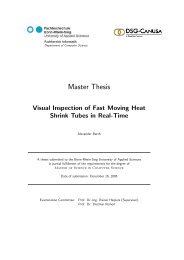Master Thesis - Hochschule Bonn-Rhein-Sieg
Master Thesis - Hochschule Bonn-Rhein-Sieg
Master Thesis - Hochschule Bonn-Rhein-Sieg
You also want an ePaper? Increase the reach of your titles
YUMPU automatically turns print PDFs into web optimized ePapers that Google loves.
6. Evaluating the safety <strong>Master</strong> <strong>Thesis</strong> Björn Ostermann page 113 of 126<br />
The safety distance of 1100 mm, according to EN 13857 in chapter 6.2.1, has not to be added,<br />
according to EN 999. The EN 999 already takes into account the crawling below the lowest beam of<br />
the protective device. For the used device setup, it gives the recommendation for the height of the<br />
“lowest beam” of protective equipment to be at 300 mm. Thus the 120 mm, which were applied in<br />
accordance with EN 13857 are just an enhancement of the safety measures.<br />
The result for the determination of the necessary safety distance is:<br />
- 664.05 mm for the evasion path<br />
- 767.65 mm for the speed control<br />
The distance of 767.65 mm, determined in the speed control is farther than the distance covered by the<br />
assumed 14 lines at which the algorithm starts to react. Increasing the lines would reduce the reaction<br />
time further, thus demanding another increase and so on. It has to be kept in mind that this particular<br />
algorithm was designed with respect to its presentability and not its speed in execution. Further<br />
projects have to implement alternative algorithms, that focus more on their execution time.<br />
Since those distances are not yet practical for demonstration, especially when the robot is only moving<br />
slowly, additional or alternative protective equipment was used, as proposed by the methodology of<br />
the standard EN 999. Thus, to be able to demonstrate the algorithms with shorter distances between<br />
robot and human, the hold to run button of the control panel was used in the course of this project as<br />
alternative protective equipment.<br />
6.4 Desired safety<br />
To be able to use the system in praxis, a safety distance of 500 mm, according to EN 349 [68] the<br />
safety distance against crushing of the human body, would be applicable. In this chapter it is shown,<br />
how short the reaction time of a system needs to be, in order to allow such a safety distance, while still<br />
operating the robot at full speed.<br />
Equation 16 is expanded by the distance the robot can move during the reaction time of the system,<br />
resulting in Equation 18.<br />
�K �T<br />
�� C � �V �T<br />
�<br />
SR �<br />
R<br />
Equation 18: Safety distance of the robot, including the robot’s velocity<br />
In Equation 19 the values are inserted, including the maximum speed of the robot, 4 m/s. This speed is<br />
far greater than the safety speed (250 mm/s), used in this project.<br />
500mm<br />
�<br />
452mm<br />
� T �<br />
5600mm<br />
/ s<br />
� T � 81ms<br />
�1600mm / s �T<br />
��48mm � �4000mm / s �T<br />
�<br />
Equation 19: Desired reaction time of the complete system














